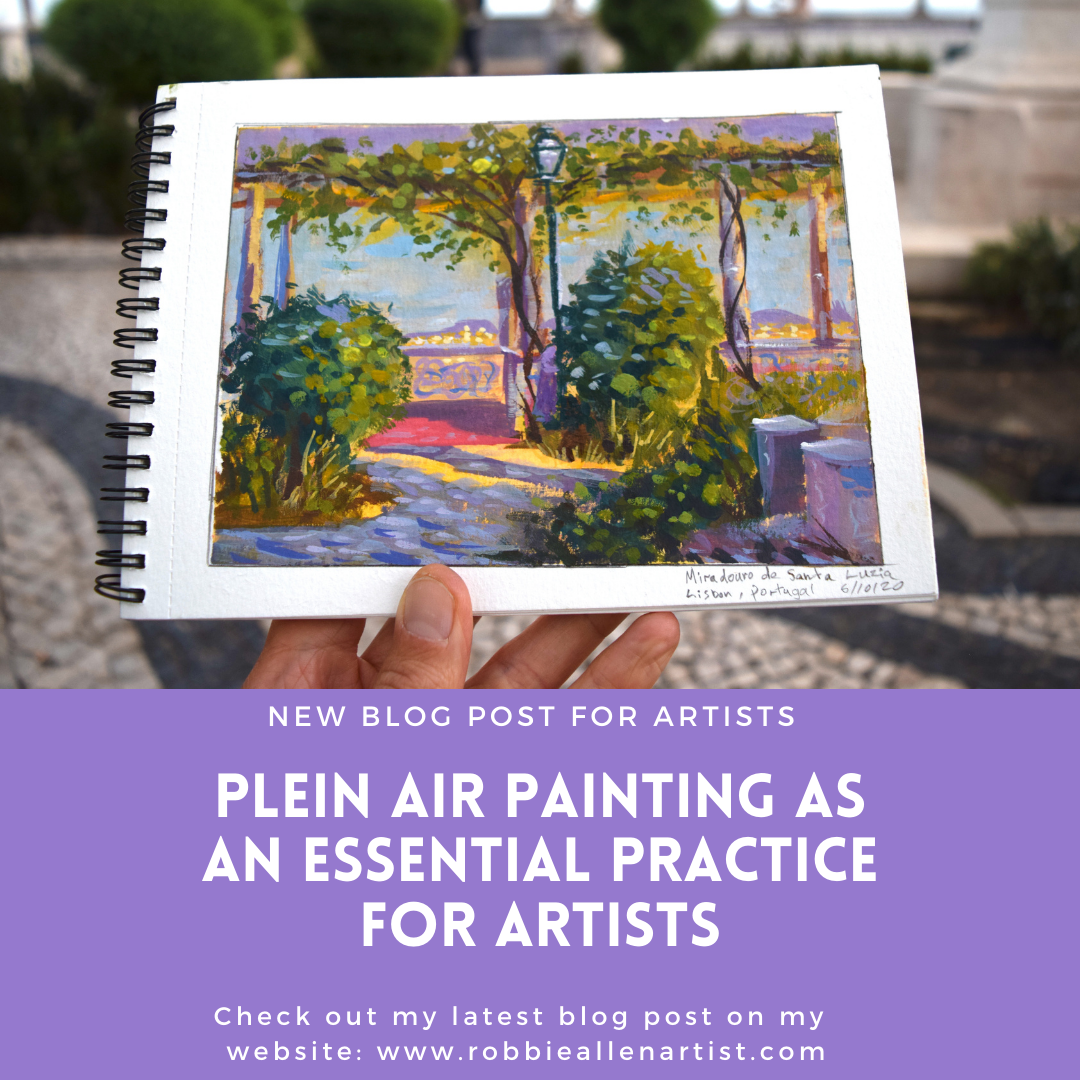
For hundreds of years, artists have sought to capture something of the colour and light in landscapes, and beauty found in nature.
Many of the great masters, who’s work we are able to witness in museums, often spoke about the importance of getting outside and painting as much as possible ‘en plein air’.
But why is the practice of plein air painting different from painting from a photograph inside the studio? And why should we aim to practice getting out into the elements to paint on-site regularly, whatever the weather?
From my own personal journey so far, I can tell you that, nothing quite compares to the experience of painting from life, both from the live model inside the studio, and in the field, on top of a high cliff looking out across the coast and sea, sitting down an urban alleyway, or by a lake, looking up at mountains, glaciers, and surrounding forests.
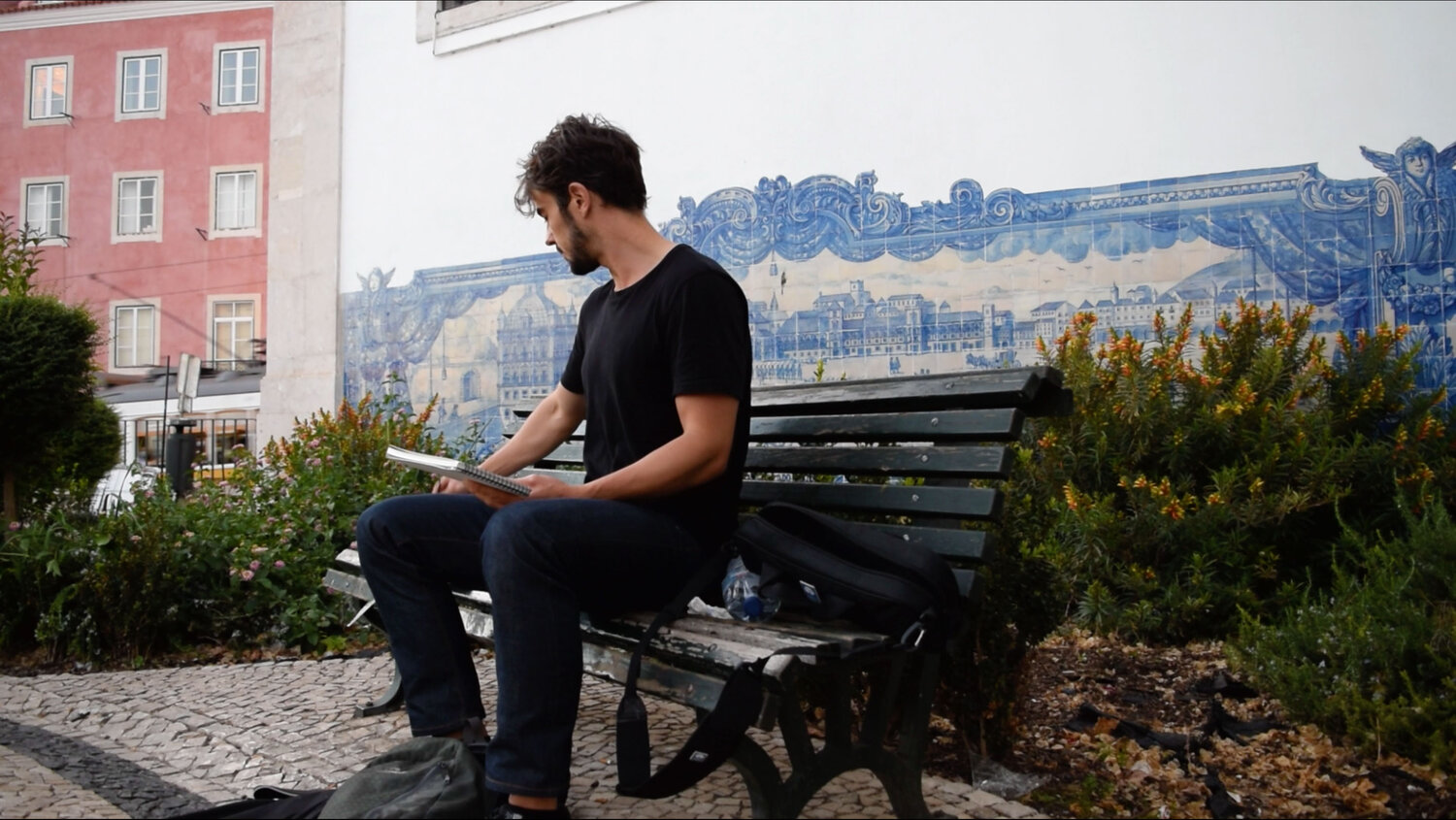
Above image: A photo of me sitting and painting ‘en plein air’ on a bench, in Lisbon, Portugal October 2020.
As artists, when we place ourselves under some level of pressure such as painting from life, I believe we often produce our best quality of practice, concentration and focus, whether that be with a definite time-limit where a model is being paid to pose, or the inner knowing that immediacy is of the upmost importance when out in the elements, as the conditions can change rapidly, and so can the light.
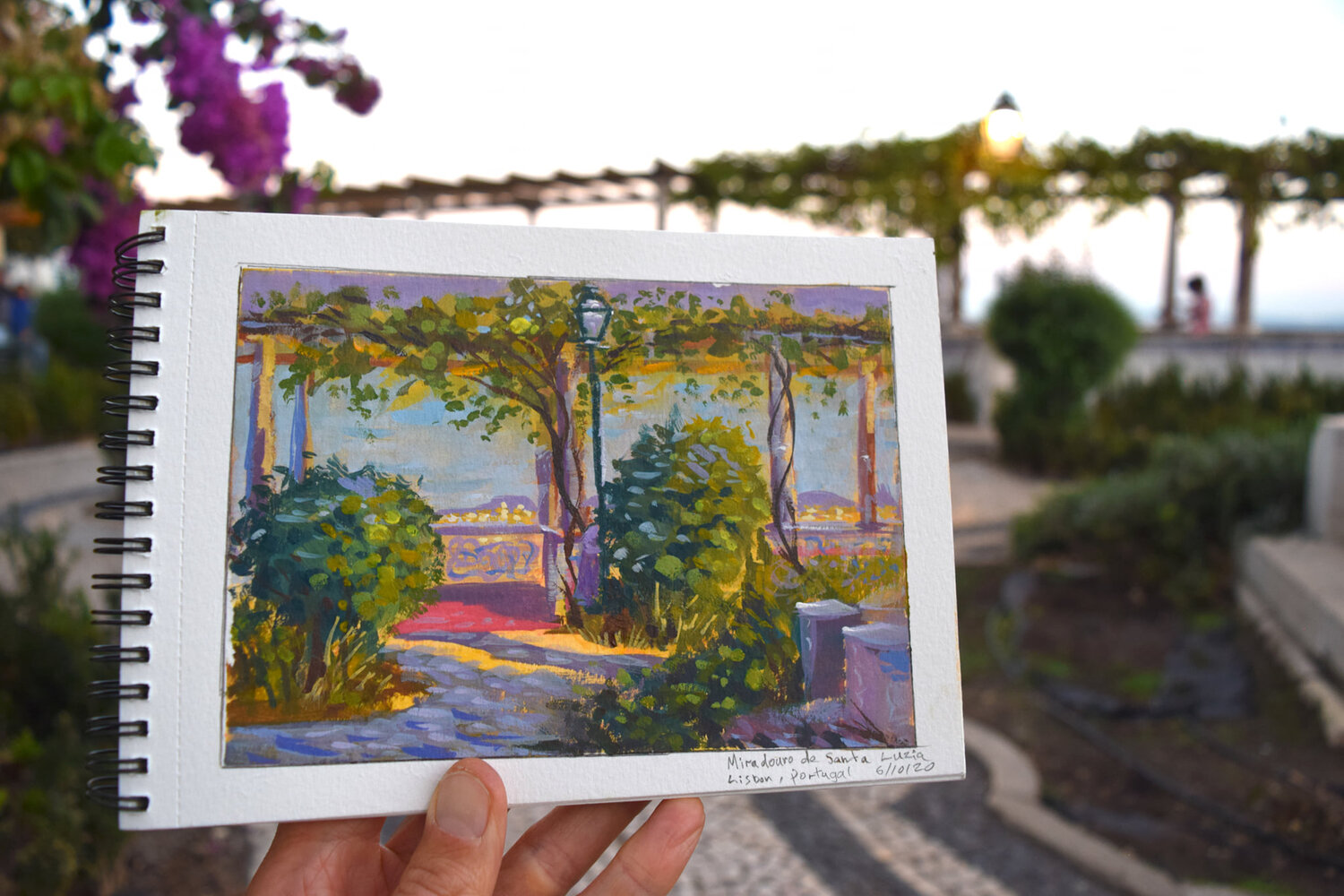
This was the view of my finished painting study from the same bench I was sitting on in the photo above. This place was called Miradouro de Santa Luiza in Lisbon, Portugal. A place a lot of tourists and couples flock to at sunset.
Painting Outdoors vs. Painting Inside The Studio
There is a number of advantages to painting from life, or en plein air. It seems to be more of a relaxed drawing or painting process when not working directly from life. When working from photo reference in a studio, you can allow yourself to move and paint slowly. You can give yourself more room to play with experimental practices and new techniques without too much consequence. You are more likely to listen to a podcast or something similar playing in the background, and reduce your full attention to think, mix colour, calculate and paint. But when you bring yourself to study the figure, or landscape directly from life, whilst committing your full focus, a whole new experience presents itself to you.
Below are some of the abilities, skills and situations that I think you will find yourself in when painting from life.
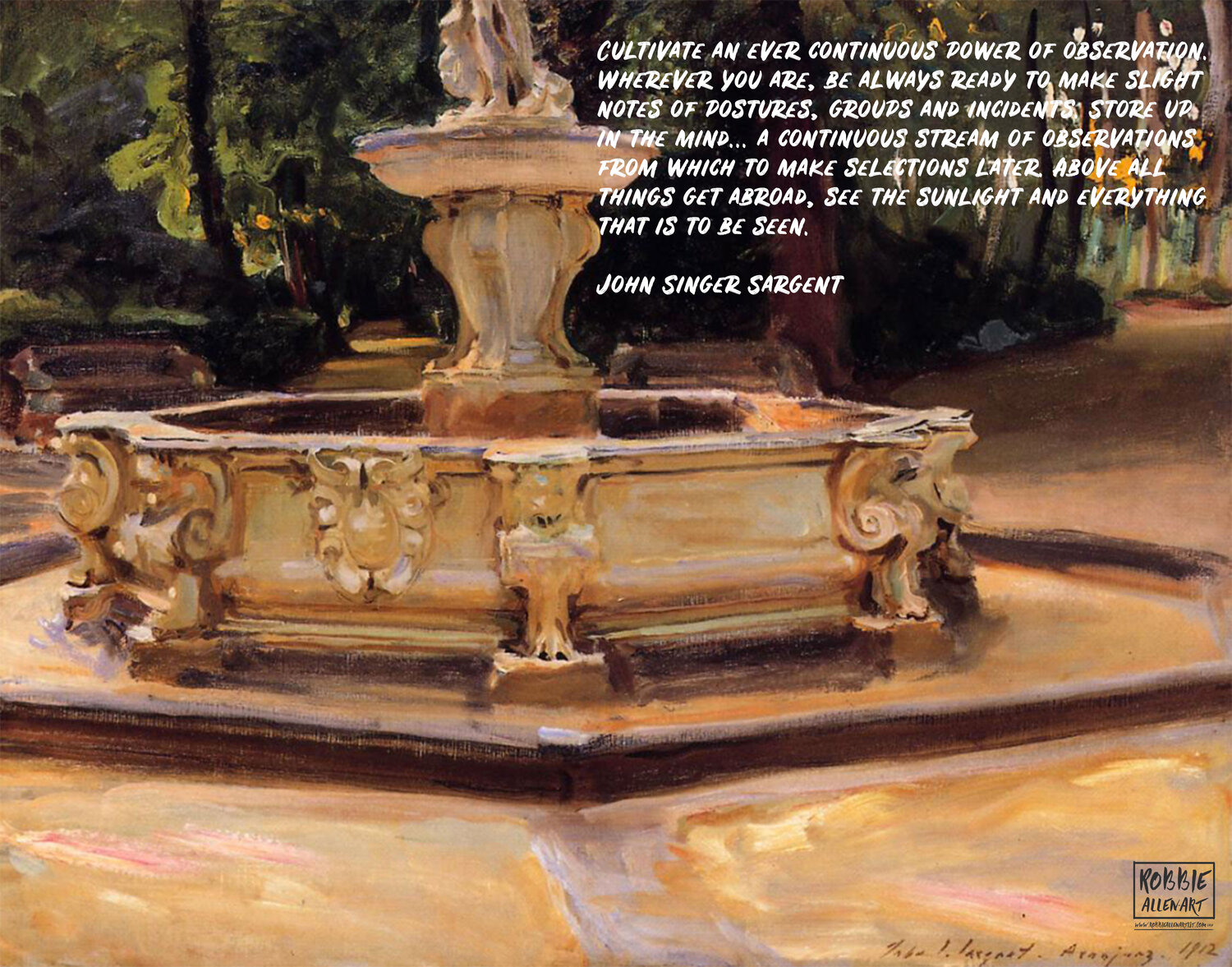
Above image: This is my graphic that I created for one of my favourite artist’s John Singer Sargent. This is his painting ‘A Marble Fountain at Aranjuez, Spain ~ John Singer Sargent, 1912’
“Cultivate an ever continuous power of observation. Wherever you are, be always ready to make slight notes of postures, groups and incidents. Store up in the mind... a continuous stream of observations from which to make selections later. Above all things get abroad, see the sunlight and everything that is to be seen.”
- John Singer Sargent
Light, Atmosphere & Increased Observation
When outdoors, you are exposed to different kinds of lighting, things like atmospheric perspective and temperature. An overcast day will provide you with different conditions than a scorching hot day in the desert with direct sunlight, or a cold, windy, and rainy winters day in Ireland, Scotland or England.
These different painting conditions provide the painter with unlimited colour and lighting effects, and not only that, you are there in the environment, you are able to feel, sense, and experience where you are fully, and this has an impact on your work. I find that I am much more likely to notice and observe the subtle colour and light changes with my own eyes, compared to looking at a photograph.
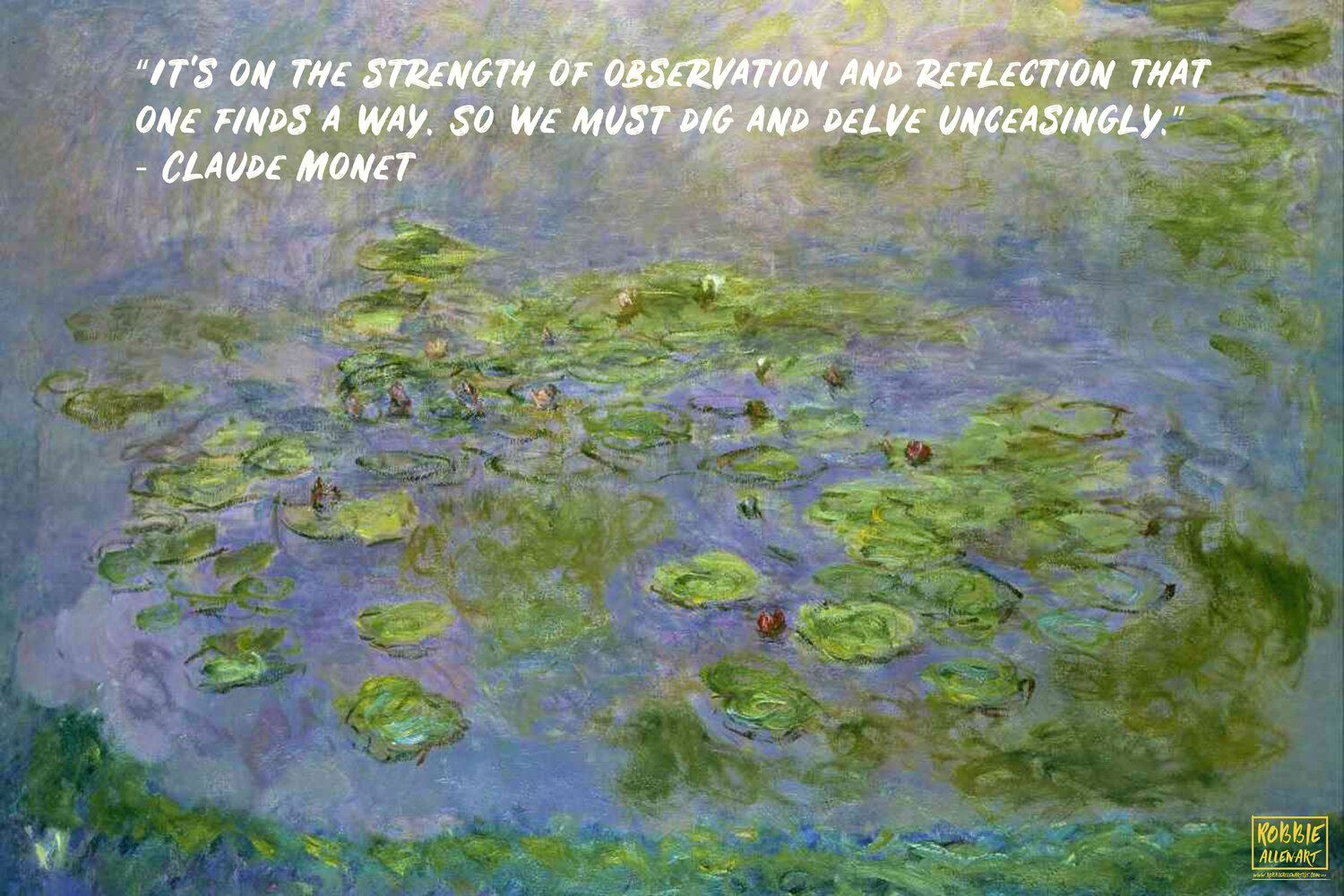
Above image: The graphic I created for Monet’s quote and painting, ‘Nymphéas Waterlilies’ 1914-1917
“It’s on the strength of observation and reflection that one finds a way. So we must dig and delve unceasingly.”
- Claude Monet
Heightened Concentration
By painting outdoors, or from a live model, we know that we are about to commit ourselves to a challenging experience where we must use all of our senses and be fully present and concentrated on the task we have before us, in the moment. This forces us to do our very best for a period of time where we are less likely to be distracted, and really get into the ‘flow’ or enter a ‘flow state’ during the process.
I do think there is an increase in concentration levels that comes with painting from life, especially when you are outside when you are breathing in the fresh air, and fully aware that your painting conditions can change in an instant. It forces you to show up, it forces you to focus and do your best work.
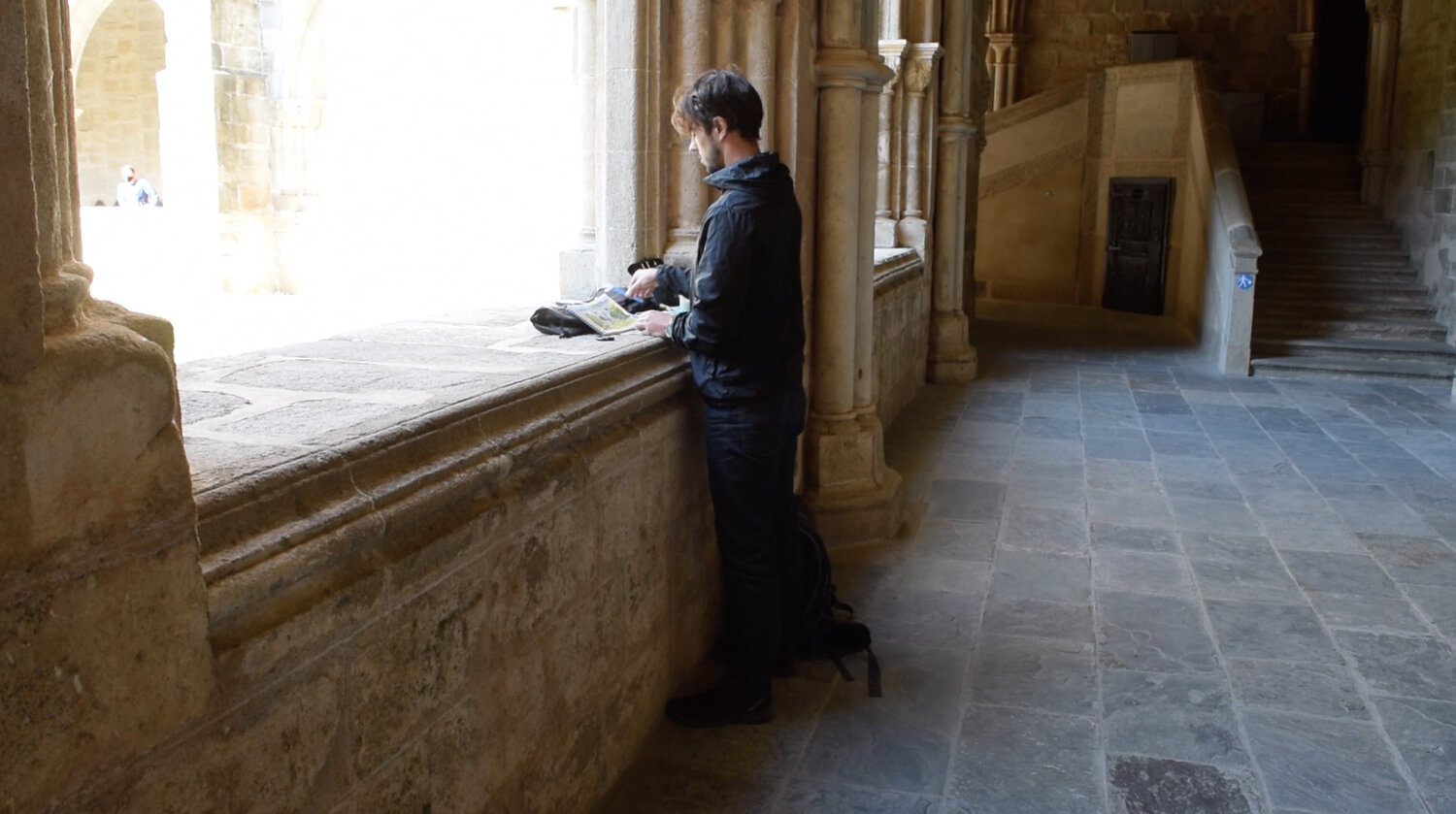
Above image: A photo of me painting inside the medieval cathedral cloister in Èvora, Portugal, October 2020.
The Challenge
A challenge calls us to activate our competitive nature. It pushes us to do our very best, testing ourselves against ourselves, or another professional, to see what we really know, and what we are capable of. A lot of us like to ‘rise to the challenge’ so to speak, and when we do, we feel far better about ourselves for at least trying. Because showing up and committing takes courage. Making yourself as an artist, go out and paint from life, is easier said than done for many. I have spoken to other artists who feel they lack the confidence to try to paint outside.
But by showing up and trying your best, you will gain confidence.
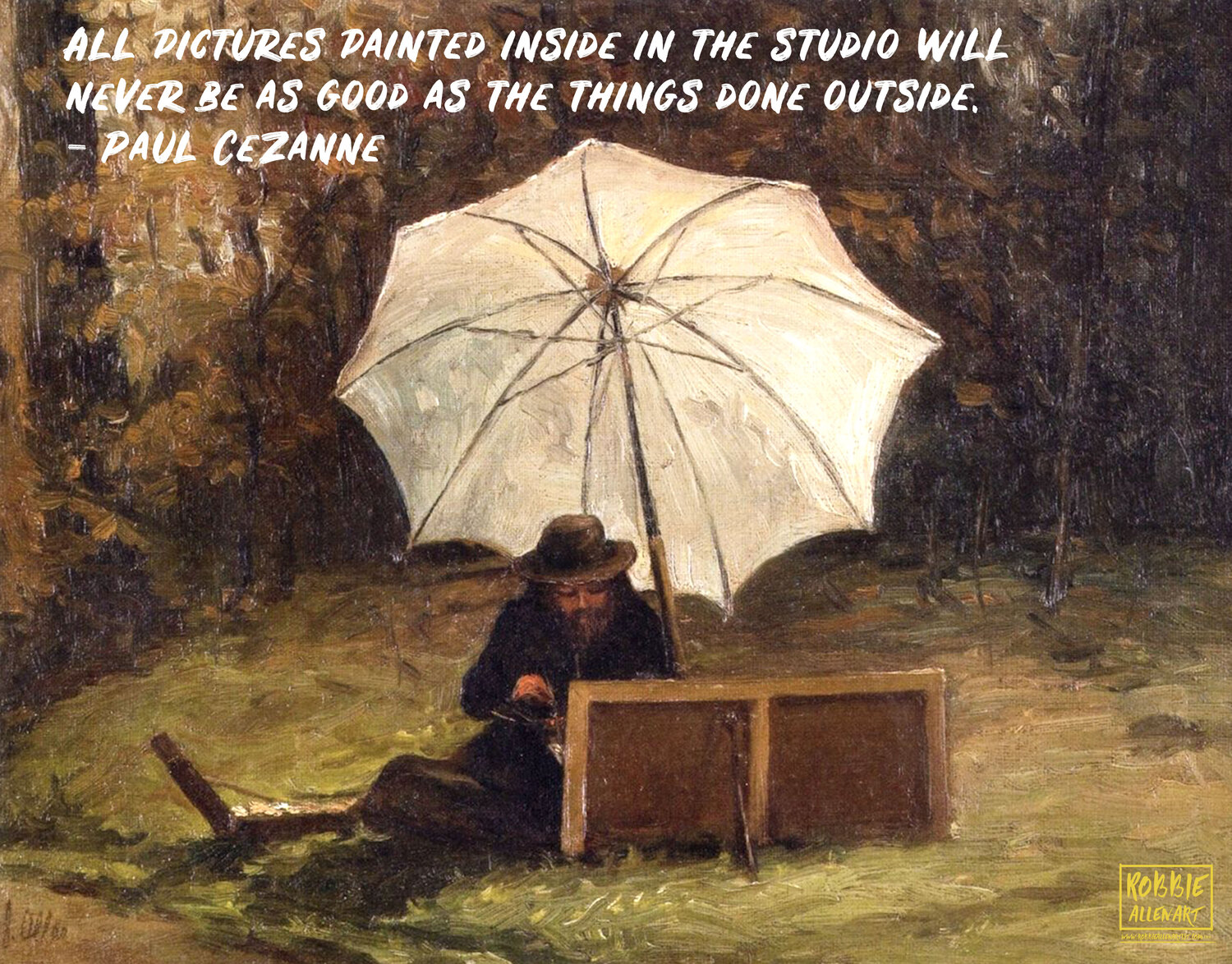
Image above: A painting of French painter Paul Cezanne painting En Plein Air.
Your Eye’s Extra Sensibility & Perception
The camera lens can only capture so much from a scene we take a photograph outside. I have often compared a photo I have taken on location, versus what I actually see, and usually, the results are quite different. This has still proven to be the case once I have taken my photographs back home, and opened them up on a laptop, without any outside glare interfering with what I can see on the camera screen.
Your ability to see around forms in 3D with both eyes enables you to see and perceive much more than you can from a flat photograph taken through a lens.
Decision-making.
While plein air painting, we are forced to make quick, deliberate decisions that are not as common practice in the studio. In the studio, we are more likely to have some other distractions around us, we allow ourselves more time, or sometimes, we don’t even give ourselves time constraints. We are more likely to have extended breaks, and then get distracted by other things, and before we know it, our time is up and we have to do something else. I have noticed I can become less deliberate with my brush strokes when I don’t have a time limit with my work. This can lead to procrastination and putting off finishing tasks, or constantly reworking them in a perfectionist manner.
But when we are painting outdoors, there’s no messing around. We have to become quick, sharp, and efficient. Nature has become our training ground where anything can happen, and this kind of practice I believe is very beneficial to take back into the studio.
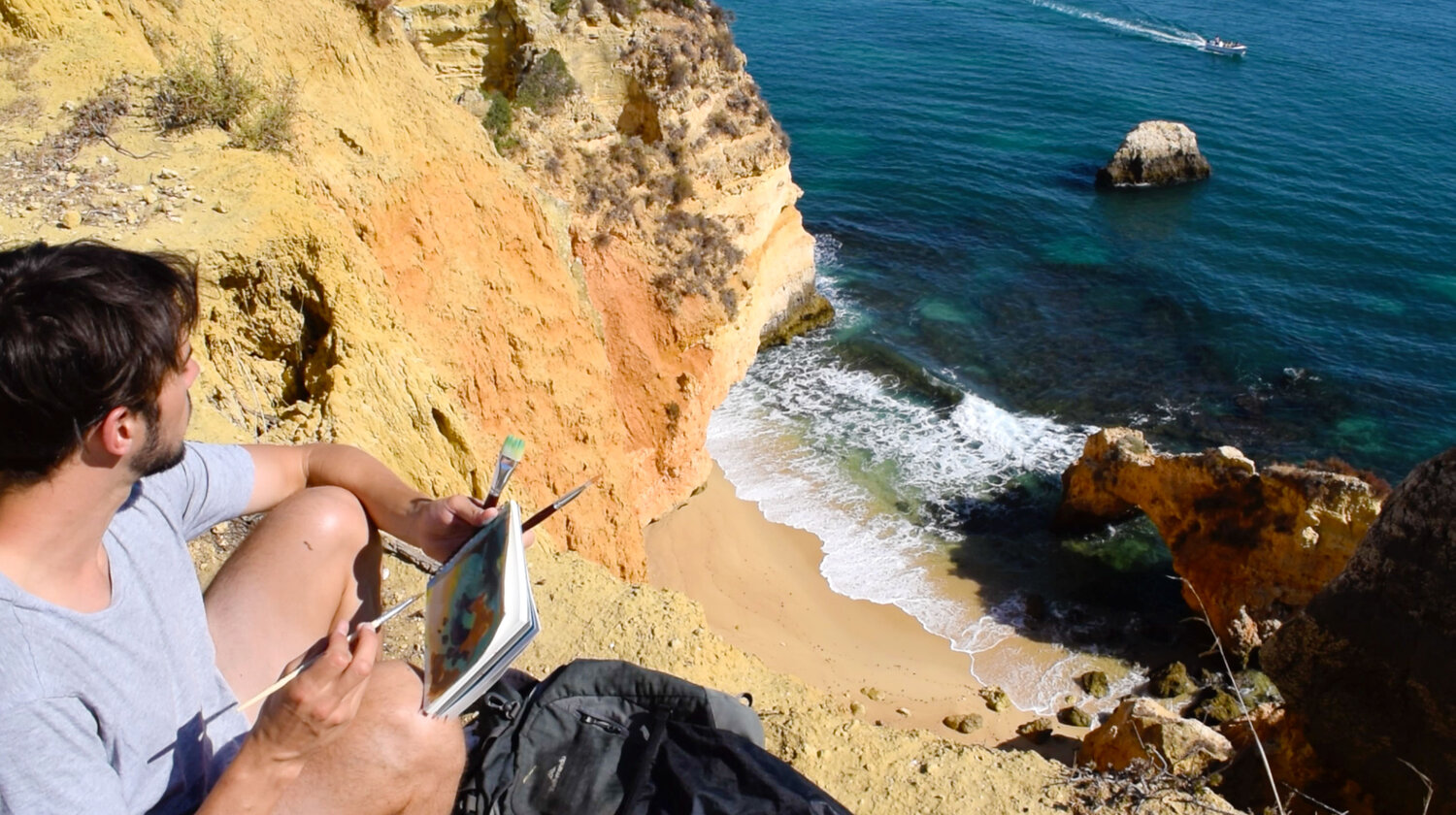
Above image: This is a photo of me, painting by a cliff edge of the cove below, in Lagos, Portugal, October 2020. The boat passing by suddenly caught my attention.
Ability To Perceive Warm And Cool Colours In Greater Depth.
You might be surprised at what you can observe and detect in terms of what is called bounce light, reflected light, skylight, and colours in shadows when painting outdoors. It is almost imperceivable to detect slight changes in colour temperature in the shadows for instance when looking at a photograph compared to real life and our own sight. But in real-time, shadows can come to life, and we can notice lots of different colour variations within them, all vibrating together. We should take note of these observations, and bring them into our paintings.

Above image: This was a recent plein air painting I finished in Lagos Portgual in watercolour & gouache. As you can see with the photo, the drakest areas shadow look almost black, but this wasn’t the case in reality.
Bringing New Knowledge Back Home
One of the great benefits of painting or drawing outside is that there is so much to learn, and bring back and transfer what you learn on the field, into your art at home or in the studio. This same knowledge can be applied to both traditional and digital art.
You go out on your own hero’s journey, easel or sketchbook at hand, paints and pencils packed. Your task is to find and defeat the dragon, and paint the thing you want to learn about and master.
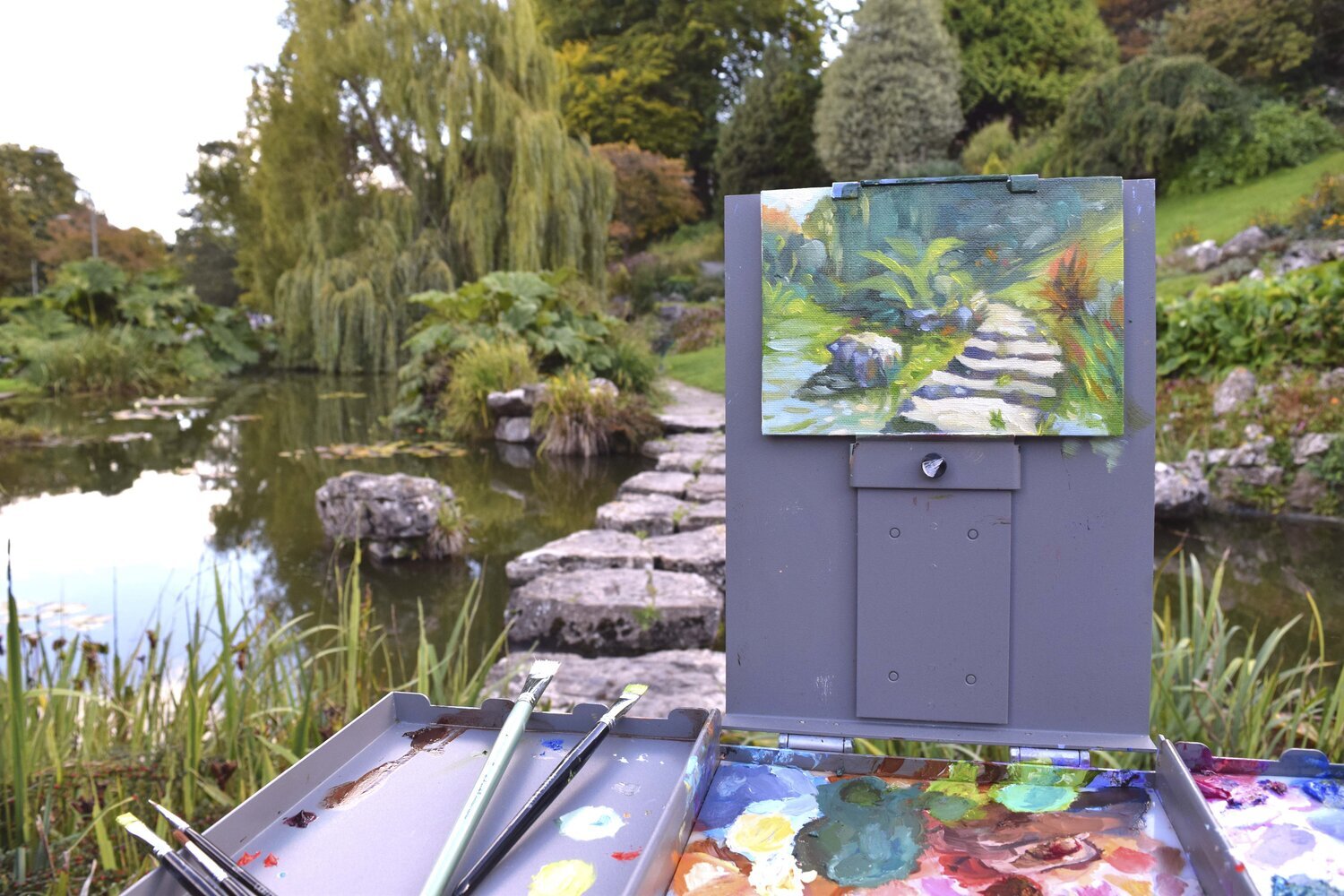
Above image: After first experiencing painting outside in New Zealand and in South America, I returned home in England and painted en plein air for the first time. This was my first landscape study in England in a place called ‘The Rockery’ Brighton, the City I grew up in. This was in 2019, painted in oils.
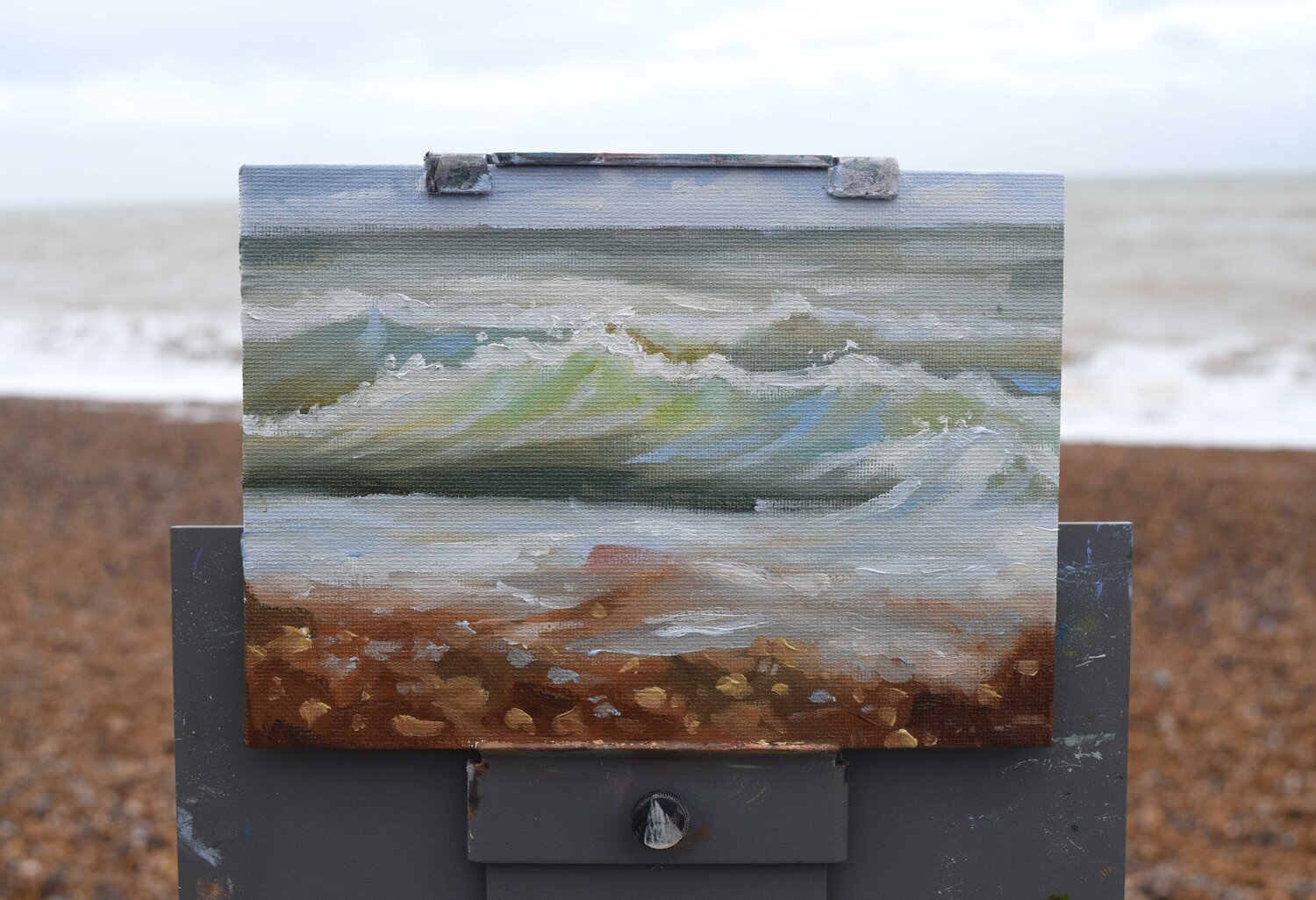
Above image: This was another one of my plein air oil paintings from my hometown Brighton, earlier this year.
Getting Outside, Especially In Nature Is Good For You
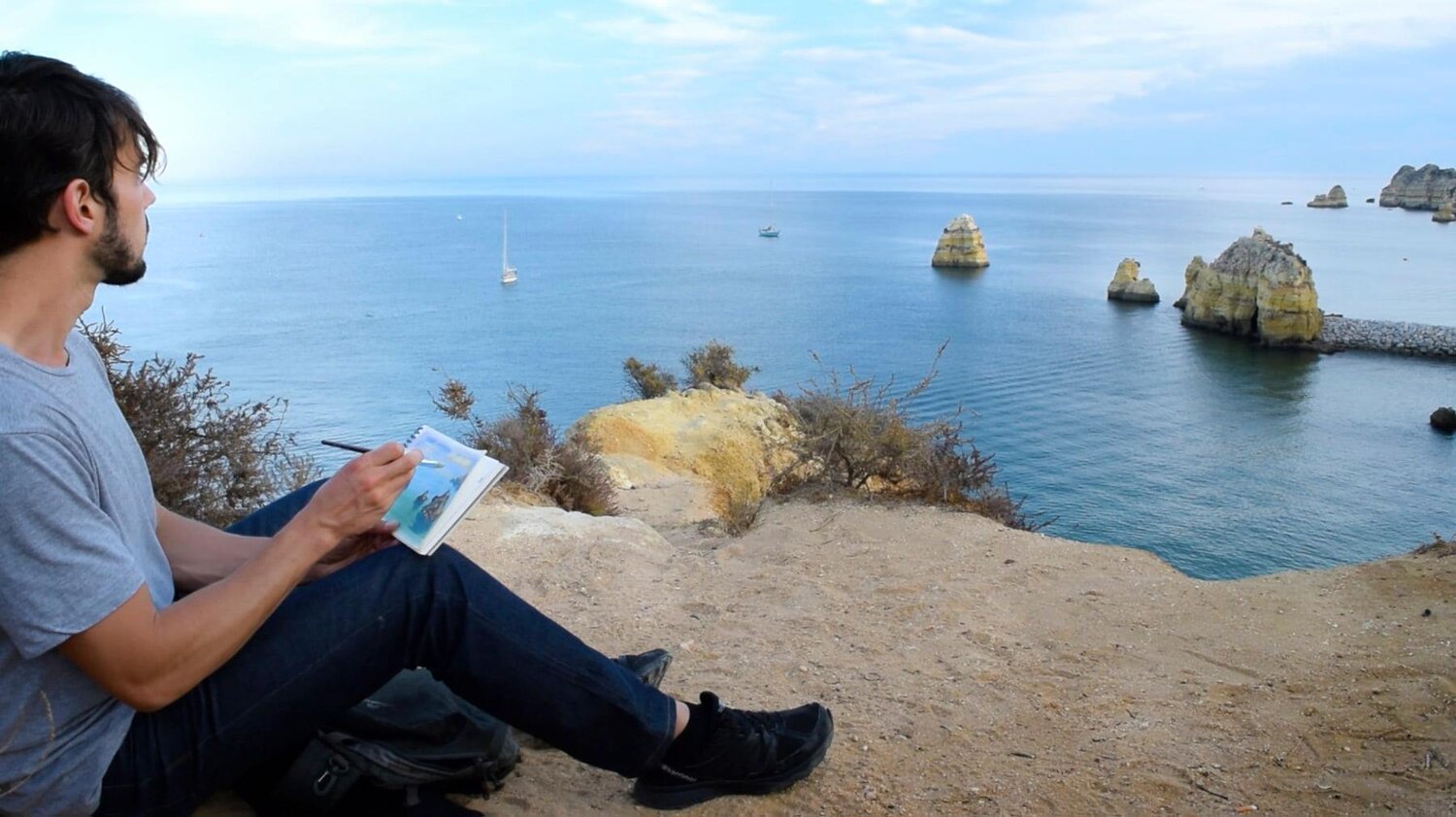
Above image: A photo of me painting in the Algarve region in Portugal, sitting in nature and breathing in the fresh air.
Plein Air Painting For Different Kinds of Art
Painting en plein air is not just an essential practice for Landscape Painters, but also for artists and painters in various fields such as Illustration, Fantasy Art, Concept Art, Design, Fine Art, and the list goes on. What you are able to learn on the field becomes an invaluable direct experience, which you can take into your work, further down the line.
I aim to take what I learn from my landscape painting practice into my own fantasy art/illustration for both digital and traditional art.
I am sure there are many more reasons why painting outside is an essential practice, but I might have to save those for a second post as I recall them, so watch out for part 2.
That was a great post - thank you. I will try this next chance I get. In the meantime I'll follow you. Cheers from Germany - Folker
@wulff-media than you, I appreciate it! I'm glad you found value in the post, and let me know if you do some painting outside, cheers!